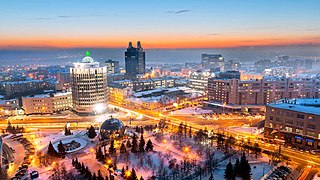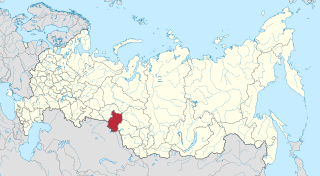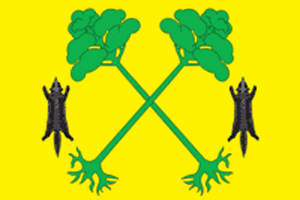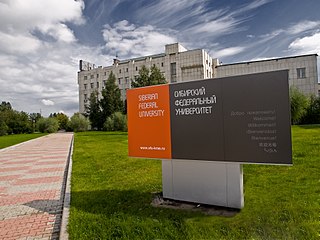
Omsk is the administrative center and largest city of Omsk Oblast, Russia. It is situated in southwestern Siberia and has a population of over 1.1 million. Omsk is the third largest city in Siberia after Novosibirsk and Krasnoyarsk, and the twelfth-largest city in Russia. It is an important transport node, serving as a train station for the Trans-Siberian Railway and as a staging post for the Irtysh River.

Novosibirsk is the largest city and administrative centre of Novosibirsk Oblast and Siberian Federal District in Russia. As of the 2021 Census, it had a population of 1,633,595, making it the most populous city in Siberia and the third-most populous city in Russia. The city is located in southwestern Siberia, on the banks of the Ob River.

Omsk Oblast is a federal subject of Russia, located in southwestern Siberia. The oblast has an area of 139,700 square kilometers (53,900 sq mi). Its population is 1,977,665 with the majority, 1.12 million, living in Omsk, the administrative center.

Krasnoyarsk Krai is a federal subject of Russia, with its administrative center in the city of Krasnoyarsk, the third-largest city in Siberia. Comprising half of the Siberian Federal District, Krasnoyarsk Krai is the largest krai in the Russian Federation, the second largest federal subject and the third largest subnational governing body by area in the world, after Sakha and the Australian state of Western Australia. The krai covers an area of 2,339,700 square kilometers (903,400 sq mi), which is nearly one quarter the size of the entire country of Canada, constituting roughly 13% of the Russian Federation's total area and containing a population of 2,828,187, or just under 2% of its population, per the 2010 Census.

Petropavl or Petropavlovsk is a city on the Ishim River in northern Kazakhstan close to the border with Russia. It is the capital of the North Kazakhstan Region. Population: 218,956. The city is also known colloquially in Kazakh as Kyzylzhar.

Tobolsk is a town in Tyumen Oblast, Russia, located at the confluence of the Tobol and Irtysh rivers. Founded in 1590, Tobolsk is the second-oldest Russian settlement east of the Ural Mountains in Asian Russia, and was the historic capital of the Siberia region. Population: 100,352 (2021 Census); 99,694 (2010 Census); 92,880 (2002 Census); 94,143 (1989 Census).

Tara is a town in Omsk Oblast, Russia, located at the confluence of the Tara and Irtysh Rivers at a point where the forested country merges into the steppe, about 300 kilometers (190 mi) north of Omsk, the administrative center of the oblast. Population: 27,318 (2010 Census); 26,888 (2002 Census); 26,152 (1989 Census).

Isilkul is a town in Omsk Oblast, Russia, located 120 kilometers (75 mi) west of Omsk, the administrative center of the oblast. Population: 24,482 (2010 Census); 26,549 (2002 Census); 26,430 (1989 Census).

Nazyvayevsk is a town in Omsk Oblast, Russia, located 120 kilometers (75 mi) west of Omsk, the administrative center of the oblast. As of the 2010 Census, its population was 11,615.

Kalachinsk is a town in Omsk Oblast, Russia, located on the Om River along the busiest segment of the Trans-Siberian Railway, 100 kilometers (62 mi) east of Omsk, the administrative center of the oblast. Population: 23,556 (2010 Census); 24,247 (2002 Census); 25,014 (1989 Census).

Novosibirsk State University is a public research university located in Novosibirsk, Russia. The university was founded in 1958, on the principles of integration of education and science, early involvement of students with research activities and the engagement of leading scientists in its teaching programmes.
Education in Siberia expanded greatly after the Trans-Siberian Railway was completed in the 19th century. While Siberia became part of Russia in the 17th century it was not until the 20th century under the Soviet Union that education was transformed which in turn brought Siberia to economic importance. This was aimed at uniting people under the Soviet. For example, the Irkutsk State Linguistic University served as "a conduit between Russia and these native people by teaching languages" during the communist era. Imperial Russia began uniting Siberia to Russia by founding Siberia's first university, Tomsk State University, in 1878.

Tyukalinsk is a town in Omsk Oblast, Russia, located 60 kilometers (37 mi) northeast of the Nazyvayevsk railway station on the Trans-Siberian Railway and 120 kilometers (75 mi) northwest of Omsk, the administrative center of the oblast. Population: 11,275 (2010 Census); 12,007 (2002 Census); 12,191 (1989 Census).

Siberian Federal University is a multidisciplinary university located in Krasnoyarsk in Siberia, that combines fundamental and applied research and teaching.
The legal system of Ukraine is based on the framework of civil law, and belongs to the Romano-Germanic legal tradition. The main source of legal information is codified law. Customary law and case law are not as common, though case law is often used in support of the written law, as in many other legal systems. Historically, the Ukrainian legal system is primarily influenced by the French civil code, Roman Law, and traditional Ukrainian customary law. The new civil law books were heavily influenced by the German Bürgerliches Gesetzbuch.

Sedelnikovsky District is an administrative and municipal district (raion), one of the thirty-two in Omsk Oblast, Russia. It is located in the east of the oblast. The area of the district is 5,200 square kilometers (2,000 sq mi). Its administrative center is the rural locality of Sedelnikovo. Population: 10,943 ; 12,211 (2002 Census); 12,890 (1989 Census). The population of Sedelnikovo accounts for 48.6% of the district's total population.
The Siberian Institute of Business and Information Technology is a non-state university in Omsk, Russia, founded in 1996.

The Yaroslav Mudryi National Law University is a self-governing (autonomous) state higher law educational establishment of the IV level of accreditation, a national university, located in Kharkiv, Ukraine, named after Yaroslav the Wise.

Maryanovsky District is an administrative and municipal district (raion), one of the thirty-two in Omsk Oblast, Russia. It is located in the southwest of the oblast. The area of the district is 1,700 square kilometers (660 sq mi). Its administrative center is the urban locality of Maryanovka. Population: 27,595 ; 27,802 (2002 Census); 30,173 (1989 Census). The population of Maryanovka accounts for 31.3% of the district's total population.
















